Choosing a Gaming CPU at 1440p: Adding in Haswell
by Ian Cutress on June 4, 2013 10:00 AM ESTDiRT 3
DiRT 3 is a rallying video game and the third in the Dirt series of the Colin McRae Rally series, developed and published by Codemasters. DiRT 3 also falls under the list of ‘games with a handy benchmark mode’. In previous testing, DiRT 3 has always seemed to love cores, memory, GPUs, PCIe lane bandwidth, everything. The small issue with DiRT 3 is that depending on the benchmark mode tested, the benchmark launcher is not indicative of game play per se, citing numbers higher than actually observed. Despite this, the benchmark mode also includes an element of uncertainty, by actually driving a race, rather than a predetermined sequence of events such as Metro 2033. This in essence should make the benchmark more variable, but we take repeated runs in order to smooth this out. Using the benchmark mode, DiRT 3 is run at 1440p with Ultra graphical settings. Results are reported as the average frame rate across four runs.
One 7970
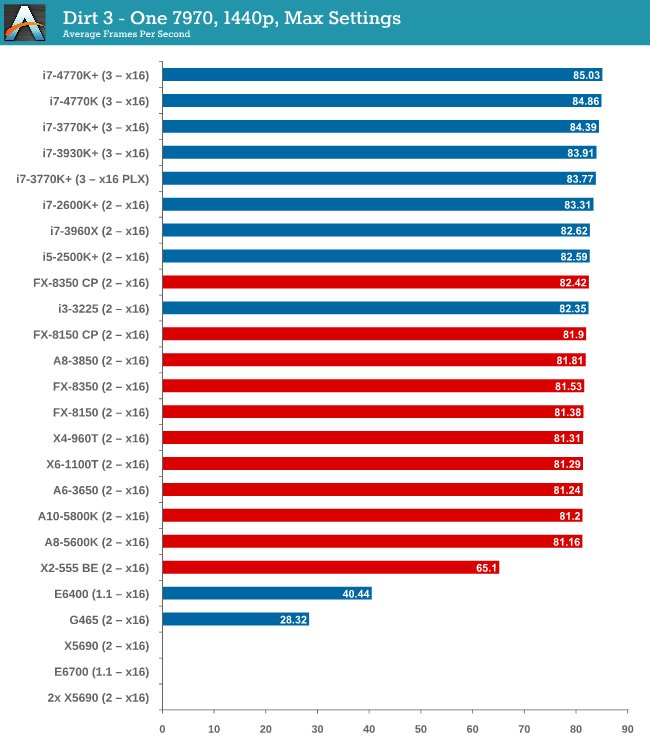
While the testing shows a pretty dynamic split between Intel and AMD at around the 82 FPS mark, all processors are roughly +/- 1 or 2 around this mark, meaning that even an A8-5600K will feel like the i7-3770K. The 4770K has a small but ultimately unnoticable advantage in gameplay.
Two 7970s
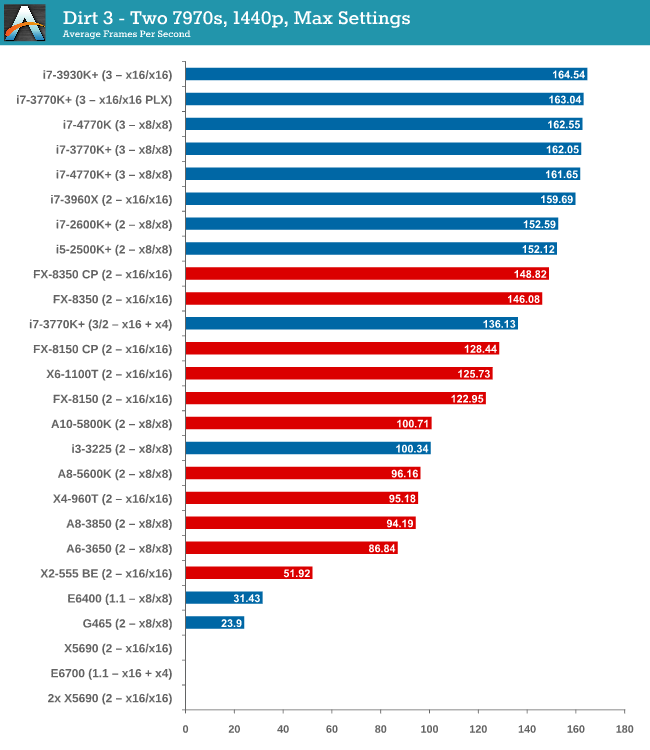
When reaching two GPUs, the Intel/AMD split is getting larger. The FX-8350 puts up a good fight against the i5-2500K and i7-2600K, but the top i7-3770K offers almost 20 FPS more and 40 more than either the X6-1100T or FX-8150.
Three 7970s
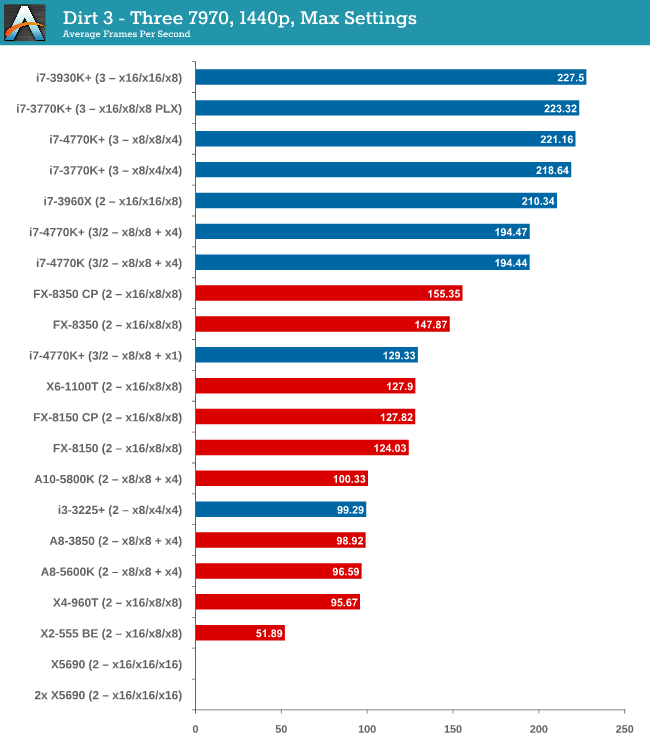
Moving up to three GPUs and DiRT 3 is jumping on the PCIe bandwagon, enjoying bandwidth and cores as much as possible. Despite this, the gap to the best AMD processor is growing – almost 70 FPS between the FX-8350 and the i7-3770K. The 4770K is slightly ahead of the 3770K at x8/x4/x4, suggesting a small IPC difference,
Four 7970s
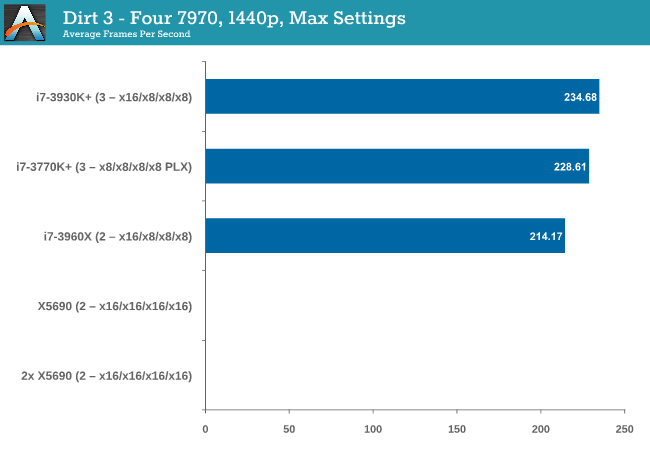
At four GPUs, bandwidth wins out, and the PLX effect on the UP7 seems to cause a small dip compared to the native lane allocation on the RIVE (there could also be some influence due to 6 cores over 4).
One 580
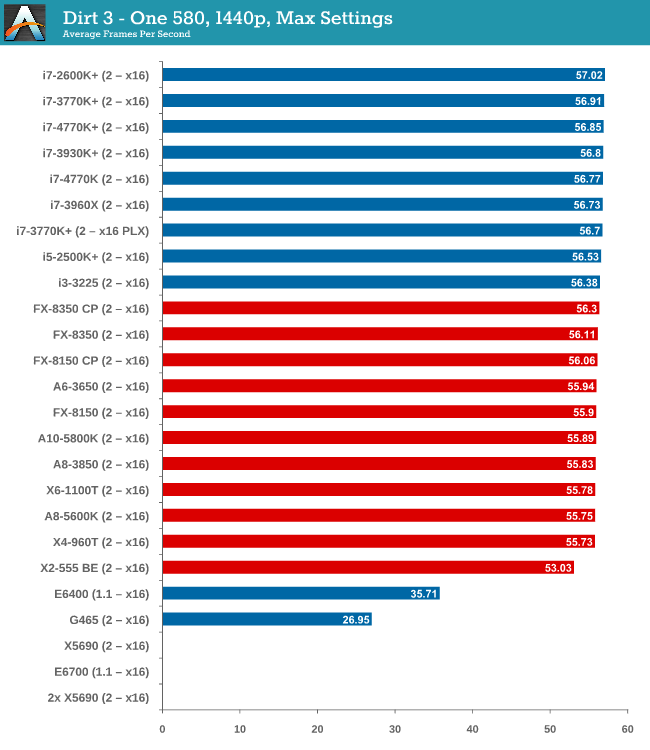
Similar to the one 7970 setup, using one GTX 580 has a split between AMD and Intel that is quite noticeable. Despite the split, all the CPUs perform within 1.3 FPS, meaning no big difference.
Two 580s
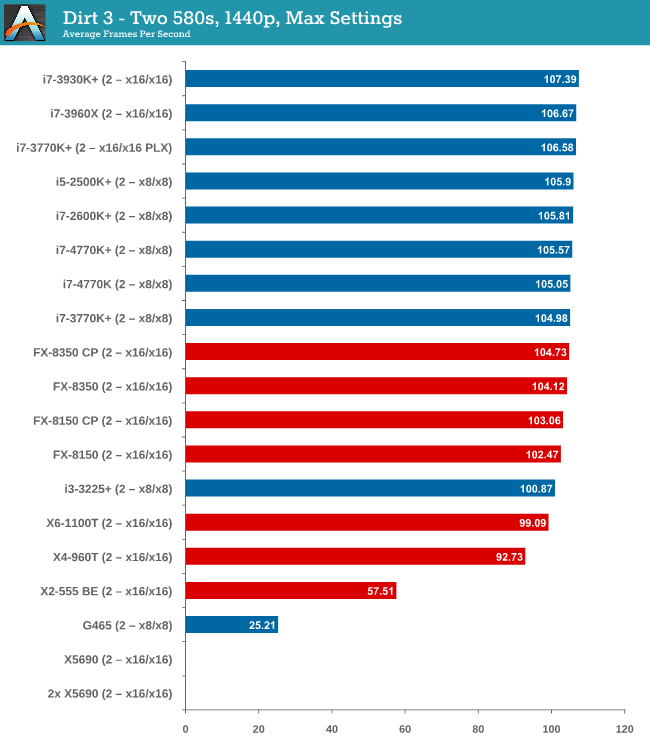
Moving to dual GTX 580s, and while the split gets bigger, processors like the i3-3225 are starting to lag behind. The difference between the best AMD and best Intel processor is only 2 FPS though, nothing to write home about.
DiRT 3 conclusion
Much like Metro 2033, DiRT 3 has a GPU barrier and until you hit that mark, the choice of CPU makes no real difference at all. In this case, at two-way 7970s, choosing a quad core Intel processor does the business over the FX-8350 by a noticeable gap that continues to grow as more GPUs are added, (assuming you want more than 120 FPS).










116 Comments
View All Comments
gonks - Tuesday, June 4, 2013 - link
Great work Ian! Definitely waiting to see i5-3570K added into the mix, to see how it compares to the i5-2500k (and the 3570k beeing more futureproof thanks to PCIe 3.0).Harby - Tuesday, June 4, 2013 - link
Excellent review, though it would be awesome to see World of Warcraft and Rift in there. Both are heavily relying on CPU.yougotkicked - Tuesday, June 4, 2013 - link
As always, thanks for the great article and hard work Ian.I'd really like to see how a few of the tests scale with overclocked CPU's, notably those in which the sandy bridge processors were competitive with ivy bridge and haswell parts. Obviously overclocking introduces a lot of variables into your testing, but it would be very interesting to see a few of the popular choices tested (sandy bridge parts @ 4.5 are quite common, and many users on such a system were waiting for haswell before they upgrade).
eBombzor - Tuesday, June 4, 2013 - link
Crysis 3 benchmarks PLEASE!!frozentundra123456 - Tuesday, June 4, 2013 - link
Interesting results, but very limited as well. Why test at a resolution used by only 4% of the players?I would have rather seen the results at 1080p, over a wider variety of games. Especially RTS games and newer games like crysis 3, FC3, and Tomb Raider. I tested Heart of the Swarm on my computer with a HD7770 and i5 2320 and was able to max out the cpu in a 10 player skirmish match at ultra, 1080p. So I am sure an A8-5600 would be limiting in that case.
Even considering the results only of the games tested, the A8-5600k seems a strange choice. The i3 seems just as valid, considering it is equal or faster in every game but one, while using less power.
makerofthegames - Tuesday, June 4, 2013 - link
Question - are those blank entries for the Xeons because they could not run, or just that data was not collected for them?Awful - Tuesday, June 4, 2013 - link
Glad to see there's no reason to upgrade the i5-2500k in my desktop yet - still happily chugging away at 4.9GHz after 2 years!holistic - Tuesday, June 4, 2013 - link
Ian,Thank you, for your time, effort, and energy in compiling an encyclopedic database on the effects of cpu on single and multi gpu configurations, in alternate gaming/engine scenarios. Your work is insightful, informative, and wholly devoted to the science of benchmarking. This approach has helped me, as a relatively new computer enthusiast, to more deeply understand testing methodology in the computing field.
I am interested in the pure CPU benchmarks of Starcraft 2 with the 4770k and 4670k. I understand this game is not optimized, is directx9, and is extremely cpu limited with only 2 maximum cores active, and thus not in top priority for providing benchmarks. Will haswell be added to the benchmarking database for sc2?
Cheers,
Craig
khanov - Tuesday, June 4, 2013 - link
Ian, I have to say (again) that i7-3820 should be in this review.You say that i7-4770K is a better value proposition than Sandy Bridge-E (X79), I assume because you are only thinking of the expensive 6 core X79 CPU's. That changes if you do consider i7-3820.
X79 brings far better support for multi-gpu setups with enough PCIe lanes to feed multiple cards quite happily. No PLX needed. Pair that with an i7 3820 (cheaper than i7-3770K/i7-4770K) and you may find the performance surprisingly good for the price.
chizow - Friday, June 7, 2013 - link
I considered the 3820 numerous times (it's cheap at MC, same price as high-end 3770K/4770K) but I shy away because it inexplicably performs *WORST* than 2700K/3770K/4770K. I don't know why, it has more L3 cache, and is clocked higher before/after boost. Just an oddball chip.Besides, X79 as a platform was dated almost as soon as it released. PCIe 3.0 support is spotty with Nvidia (reg hack not guaranteed), no native USB 3.0 and no full SATA 6G support. I went for Z87 + 4770K instead because X79 + 3820 didn't offer any noticeable advantages while carrying a significant higher price tag (board price).